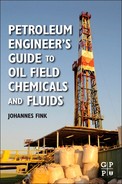0%
31Chapters
0-1Hours read
0kTotal Words
Book Description
Oilfield chemical demand has risen 4.3% annually through 2011. Gains are driven by a rise in rig counts, more use of well stimulation and enhanced oil recovery (EOR) methods, and more deepwater drilling and production. Petroleum Engineer's Guide to Oil Field Chemicals and Fluids is a guide to the benefits and trade-offs of numerous oil field chemicals used in the petroleum and natural gas industry today.Oil field chemicals are gaining increasing importance, as the resources of crude oil are decreasing. An increasing demand of more sophisticated methods in the exploitation of the natural resources emerges for this reason. Petroleum Engineer's Guide to Oil Field Chemicals and Fluids reviews the progress in the area of oil field chemicals and additives of the last decade from a rather chemical view. The material presented is a compilation from the literature by screening critically approximately 20,000 references. The book is ordered according to applications, just in the way how the jobs are emerging in practice. It starts with drilling, goes to productions and ends with oil spill. Several chemicals are used in multiple disciplines, and to those separate chapters are devoted. Two index registers are available, an index of chemical substances and a general index.
Condensed for readability, this manual provides users with information on oil field chemicals such as drilling muds, corrosion inhibitors gelling agents, scale inhibitors, and bacteria control. Each chapter follows the same template. In the introductory comments of each chapter a brief introduction to the chemical or polymer type is given and earlier monographs and reviews dealing with the topic are listed for quick reference. The text continues with monomers, polymerization and fabrication techniques and discusses aspects of application. After this, suppliers and commercial grades are collected, as well as safety aspects.
- Chemicals are ordered by use including drilling muds, corrosion inhibitors, and bacteria control
- Includes cutting edge chemicals and polymers such as water soluble polymers and viscosity control
- Handy index of chemical substances as well as a general chemical index
Table of Contents
- Cover image
- Table of Contents
- Front Matter
- Copyright
- Preface
- Chapter 1. Drilling Muds
- Chapter 2. Fluid Loss Additives
- Chapter 3. Clay Stabilization
- Chapter 4. Lubricants
- Chapter 5. Bacterial Control
- Chapter 6. Corrosion Inhibitors
- Chapter 7. Scale Inhibitors
- Chapter 8. Gelling Agents
- Chapter 9. Filter Cake Removal
- Chapter 10. Cement Additives
- Chapter 11. Transport
- Chapter 12. Drag Reducers
- Chapter 13. Gas Hydrate Control
- Chapter 14. Antifreeze Agents
- Chapter 15. Odorization
- Chapter 16. Enhanced Oil Recovery
- Chapter 17. Fracturing Fluids
- Chapter 18. Water Shutoff
- Chapter 19. Oil Spill Treating Agents
- Chapter 20. Waste Disposal
- Chapter 21. Dispersions, Emulsions, and Foams
- Chapter 22. Defoamers
- Chapter 23. Demulsifiers
- Appendix 1. List of Tradenames
- Appendix 2. List of Acronyms
- Subject Index
